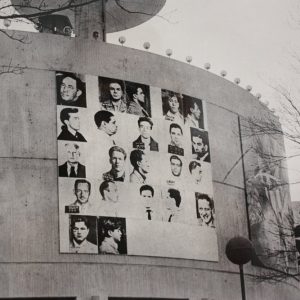As I See It With Bruce Helander - Jump for Joy
Sep 8, 2016
Like most of us, if you were constantly glued to the TV during the last few weeks, it was likely due to the Olympic Games in Brazil. And no wonder, as athletes from the United States won a record number of medals (121), including a total of 46 golds, more than any other country.
For the art world, the parallel to Olympiad achievement is the international attention and excitement surrounding auction houses like Sotheby’s or Christie’s during an important evening auction, which officially recognizes the winning bid that quite often, just like the Olympics, goes down to the final seconds as an historic benchmark to beat. Bona-fide living “art stars,” like Jeff Koons, Damien Hirst, and Jasper Johns, all made it to the top by developing their remarkable natural talent, self-confidence, determination, burning ambition, discipline and determination, a competitive spirit and passion for perfection, again with a similar parallel to 2016 Olympian winners like Canadian high jumper Derek Drouin, U.S. swimmers Katie Ledecky and Michael Phelps, and (aptly named) sprinter Usain Bolt from Jamaica, called the “fastest man alive.” In the track races in Rio, it was the 'bang' of the starter pistol that initiated the collective contest of wills as the runners dashed forward to hopeful stardom, and all participants focused on crossing the finish line, often with a painful final push to break an existing record or even a score. Come to think of it, the sound of the shot in the air is a bit similar to the amplified echo of an auction hammer during a major evening sale in Manhattan, as the last moments of jockeying for position and frenzied bidding ends, the crowd goes wild, and the winner is assigned bragging rights and the privilege to run with the art.
All this concentrated running and jumping and swimming were reminders of my similar activities many moons ago in high school. I was attracted to participating in track and field events that eventually consumed my after class time, with workouts nearly every afternoon. I ran the medley relays, and was a high jumper and pole vaulter for a few years, until I realized the physical commitment was overwhelming. My interest in becoming an artist finally ruled out serious sports as I pursued a career in fine art. Once I got to College Hill in Providence to attend the Rhode Island School of Design, sports faded into the background as my dedication to exploring my true love of painting became a fascination that never went away. Years later, I am happy to say that I have reached my own ambitious goals to be a successful artist, writer and museum curator with no regrets.
In general, art and sports don’t mix naturally, except that those practitioners should be in reasonably good physical and emotional condition and have special talents in order to favorably compete. Recognizing the value of incorporating public art in and around the Olympic stadium in Rio, an artist in residence program was inaugurated, intending to “...open up Olympism and its values to the widest possible audience,” according to a statement by the Olympic committee. The French artist somewhat anonymously known only as JR, has had the biggest visual impact in Rio of all other public works on display. His 2008 installation, Women are Heroes, where he spliced together over-sized photos of female faces and eyes and pasted them on structures around town, including slums, earned him the coveted TED prize a few years later. It’s still hard to believe that hugely successful former non-profit street artists, such as Keith Haring, Banksy and Shepard Fairey, who displayed their “illegal” work without permission, often resulting in an arrest, owe everything to the public 24-7 subliminal exposure their art enjoyed early on. With enough coverage and comments, the thankless job of shimmying up an apartment building to glue down a predetermined set of multiple images started having its advantages, as the vernacular of this art literally made for the streets started to receive more views and acceptance on a daily basis than those that can be found in a museum or gallery. It is not at all surprising that some art fairs currently are featuring wall fragments from commercial buildings that were excavated to salvage an early Banksy stencil painting originally worthless, but currently can be sold for a hefty sum.
Well, for the moment, the artist known as JR is not exactly on his way to the Banco de Brasil, as money clearly is not a priority, but testing the limits and values of communicative devices through teamwork and interaction with the community is. JR creates the visual magic anointing him as the most recognized de facto collage artist on the grandest scale in history. As one example, this summer, JR and his team collected portraits of world-class athletes, as well as volunteers and others associated with the Olympic Games' opening ceremony, and increased the sizes on paper to about 5 feet high, which were then pasted and stacked up and across. The results were exciting, and could not be missed by anyone strolling by casually. I’m reminded of Andy Warhol’s most infamous public commission, done for the New York Pavilion at the 1964 World’s Fair, where he created a series of controversial printed mug shot images of the F.B.I.’s “Thirteen Most Wanted Men.” It cost Warhol about $4,000 to make, only to have the work rejected by then-Governor of New York, Nelson Rockefeller, and sadly, was painted over before the fair even opened. It was another Rockefeller, the industrialist tycoon and “art collector” John D., that challenged Diego Rivera in 1932 to alter the artist's already completed mural commission, because Rockefeller didn’t appreciate the political content, or take the consequences of having it chiseled off the wall. Guess what happened? Times have certainly changed, and now the notion of celebrating the efforts of “street artists,” their freedom of speech, and the visual vitality of public murals are commonplace in many urban centers around the world. In fact, public “street art” literally has changed and charged up the urban landscape in communities like Miami, through the Wynwood Walls initiated by the late Tony Goldman, and in the vibrant City of West Palm Beach, now even more of a tourist destination because of CANVAS, the outdoor murals project that is the brain child of organizer and art dealer Nicole Henry.
The artist JR turns urban landscapes into massive poster-like sections, consisting of pasted-down squares placed together whose strength is in numbers. But JR doesn’t stop with two-dimensional wall murals, as a visit to the Brazilian city of Rio de Janeiro reveals almost instantly. Perhaps the most pioneering and unique public art created within the last decade, these huge mixed media outdoor works, embellished with photographic transfers, are supported by meandering but carefully planned scaffolding that reinforces the shape of a giant Olympian figure. For example, a spectacular portrait of the French triathlete Léonie Périault rises out of Guanabara Bay in Rio, with nearly a 100-foot wingspan of arms making it looking ready to dive back into the sea. It has become the most ingenious and arresting giant sculptural “billboard” since viewing Kara Walker’s monumental sugar “Sphinx” that was installed inside Brooklyn's cavernous, abandoned Domino Sugar Factory few years ago. Another illustration of extreme invention by JR is a rooftop sculpture set high in the sky and braced by framework that depicts Ali Mohd Younes Idress, a Sudanese athlete unable to compete in the Olympics due to injury, but who convincingly appears here to be leaping over an abandoned building in the airborne upside down position of the award-winning high jumper that he is. A perfect creative decision for repositioning an image of a giant champion jumper in flight. “Look, up in the sky! It’s a bird! It’s a plane!...Able to leap over tall buildings in a single bound!” As Superman’s vintage comic book introduction exclaims, JR brings a whole new meaning to capturing the high flying winning spirit propelled by human velocity and determination, giving others a true run for their money.
For more information the artist JR, please visit: http://www.jr-art.net/
Author

Bruce Helander
Bruce Helander is a former White House Fellow of the National Endowment for the Arts and is the former Editor-in-Chief of The Art Economist magazine. His columns on art, values, and investing in art appear regularly in The Huffington Post.

:sharpen(level=0):output(format=jpeg)/wp-content/uploads/2016/09/as-i-see-it-with-bruce-helander-jump-for-joy.jpg)



:sharpen(level=1):output(format=jpeg)/wp-content/uploads/2024/05/The-Art-Lawyers-Diary-1.jpg)
:sharpen(level=1):output(format=jpeg)/wp-content/uploads/2024/04/5-Questions-with-Bianca-Cutait-part-2-1.jpg)
:sharpen(level=1):output(format=jpeg)/wp-content/uploads/2024/05/20231208_164023-scaled-e1714747141683.jpg)
:sharpen(level=1):output(format=jpeg)/wp-content/uploads/2024/04/header.jpg)
:sharpen(level=1):output(format=jpeg)/wp-content/uploads/2024/04/5-Questions-with-Bianca-Cutait-part-1-1.jpg)
:sharpen(level=1):output(format=jpeg)/wp-content/uploads/2024/03/5-Questions-with-Alaina-Simone-1.jpg)